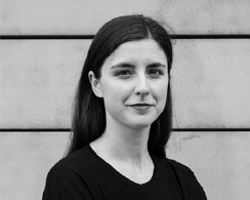| Emilia Bruck |
 |
|
| Description of the ThesisAs the technology of automated and connected vehicles will continue to evolve, there is no unified stance amongst urban practitioners towards its planning requirements. While the scientific community considers possible spatial effects to be far-reaching, urban planners and public officials are yet to recognize the urgency of defining an agenda. Meanwhile, technological test-cases are deployed and urban visions predominantly sketched by technology companies or consultancies. The study, thus, focuses on transformative processes, which occur in relation to emerging mobility technologies, such as automated and connected vehicles. Special attention is given to novel actors, due to the convergence of the automobile and IT industry, as well as the asynchronicity between spatial transformations and incremental changes in urban planning principles. It further questions how experimental lab deployments contribute to the revision of planning approaches and processes. Just as times of change have historically affected the realignment of professions, the research reflects upon planning paradigms and novel practices against the backdrop of technological transformations. Qualitative research methods are applied for a comparative case study in Toronto, Canada, and Vienna, Austria. In each of the two cities newly built urban development areas have been designated as deployment sites for the city’s first automated shuttle service, however naturally their planning cultures and genesis greatly differ. The study of current planning and policy documents is therefor embedded in a literature based historical revision of local planning paradigms and their changes in recent decades. Built form and spatial visions are then analysed in reference to local planning paradigms as well as spatial affordance for automated and connected mobility. Qualitative interviews with representatives of urban planning, public officials and the scientific community are conducted in order to review planning and design approaches as well as the potentials and limitations of urban transformations induced by technological advances. |
Publications
Bruck E. (2018): Wie kommt Digitalität in die Stadtplanung?; in: Raumplanung. Jahrbuch des Departments für Raumplanung der TU Wien 2018, Band 6, J. Suitner, R. Giffinger, J.S. Dangschat (Hrg), NWV Neuer Wissenschaftlicher Verlag, Wien, 2018, (forthcoming)
Bruck E. & Scheuvens, R. (2018): Digitale Transformationen. future.lab MAGAZIN, 09; S. 4-5.
Bruck E., A. Soteropoulos, A. Stickler: “Technologische Innovationen im Verkehrssystem: Automatisiertes Fahren als Herausforderung für Siedlungsentwicklung und Stadtplanung; in: “Raumplanung. Jahrbuch des Departments für Raumplanung der TU Wien 2017, Band 5”, J. Suitner, R. Giffinger, L. Plank (Hrg.); NWV Neuer Wissenschaftlicher Verlag, Wien, 2017, ISBN: 978-3-7083-1143-2, S. 39 – 59.
Banerjee I., M. Berger, E. Bruck, J. Dangschat, A. Diem, M. Mitteregger, R. Scheuvens, A. Soteropoulos, A. Stickler (2017): Avenue 21. future.lab MAGAZIN, 07; S. 18.